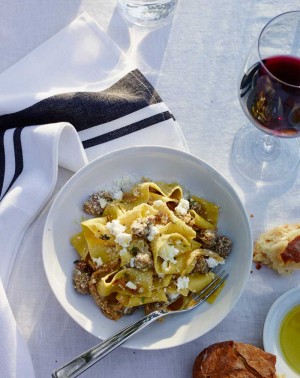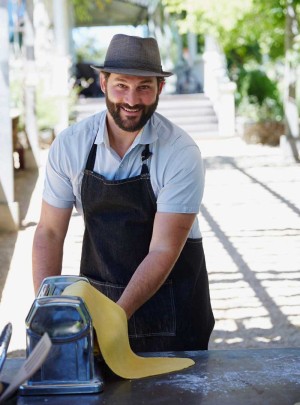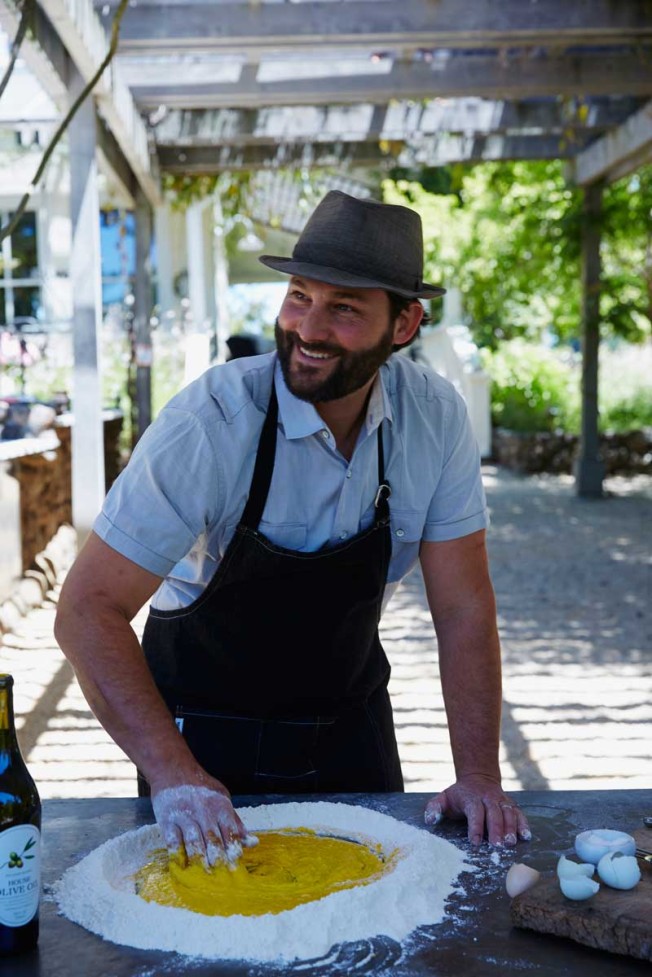At his Healdsburg restaurant Scopa, Chef Ari Rosen is known for fresh pasta. Long strands are tossed with a sugo of braised beef and pork; petite ravioli hold pockets of creamy cheese and greens. In the menu he created for our Vineyard Dinner with Scopa, Ari served fresh pappardelle with Italian sausage, fennel and soft ricotta — a standout dish demonstrating that often the traditional way is the best way. With age-old techniques and just a hand-cranked machine, you can make rich, flavorful pasta that becomes an ideal canvas for the season’s best ingredients. Here, we ask Ari how it’s done.
 What do you love about fresh pasta? What’s special about the flavor, texture, etc.?
What do you love about fresh pasta? What’s special about the flavor, texture, etc.?
Fresh pasta and fresh bread are truly flour miracles. The finished product neither resembles the flavor or the appearance of its raw ingredients. The texture is silky and sexy, and the taste matches the appearance. Fresh pasta is all about judging a book by its cover.
How did you learn to make pasta? Who taught you?
My mother taught me when I was four or five years old. She is now teaching my four-year-old daughter. It’s nice to see everything come full circle.
How do you make your pasta at Scopa? What’s special about it?
We might be one of the only restaurants who closes their ravioli with a fork. A lot of what makes Scopa special is that we really cook like old Italian grandmothers. I grew up sealing ravioli with a fork, so that’s how we do it. It’s a painstaking process, but the extra crimping on the edges creates a thin melt-in-your mouth border. Oh, and if we didn’t do it this way my mother would complain that the ravioli was too thick and chewy.
We also get phenomenal local eggs from both chickens and ducks. The rich color and flavors of these eggs makes our pasta some of the best around.
 Any tips for people making fresh pasta at home?
Any tips for people making fresh pasta at home?
Put on your favorite music and don’t rush it. Take your time, and enjoy the sensuality of making fresh pasta (think like water for chocolate). The love you put into the pasta carries into the experience of eating it.
How can you use pasta as a canvas for other seasonal flavors?
Pasta really is the canvas for seasonal ingredients. Choosing the right pasta for the right sauce is both fun and challenging. Dried pasta has small grooves that hold on to sauces and oils; they also are cut into specific shapes that can make or break a dish. Fresh egg pasta really adds a richness and flavor to the dish, so keep that in mind as well.
Remember, play with dried pastas to get sauces to cling to noodles or to catch sauces with their unique shapes. Use fresh pasta for melt-in-your-mouth sauces or if you want to add a richness to your sauce.
What are some of your favorite pasta dishes to make and eat? Any go-to sauces or preparations?
I love a lot of the classics. I’m a sucker for linguini and clams and a really good carbonara. Fresh pastas are good with just about everything but require some work. So, sometimes the quick and easy pasta sauces become what I eat on the regular. When I lived in Italy, after work we would make a canned tuna and tomato sauce with bucatini pasta in about fifteen minutes. It was our 2 am go-to pasta and it really hit the spot.
Find all of Ari’s recipes here.

